- HOME
- Enzyme List
- GYD-301 GLYCEROL DEHYDROGENASE
-
GYD-301
GLYCEROL DEHYDROGENASE from Cellulomonas sp.

PREPARATION and SPECIFICATION
| Appearance | White amorphous powder, lyophilized | |
|---|---|---|
| Activity | GradeⅢ 50 U/mg-solid or more (containing approx. 50 % of stabilizers) |
|
| Contaminant | NADH oxidase | ≤1.0×10-3 % |
| Stabilizer | BSA | |
PROPERTIES
| Stability | Stable at −20 ℃ for at least 6 months(Fig.1) |
|---|---|
| Molecular weight | approx. 390,000 |
| Isoelectric point | 4.4±0.1 |
| Michaelis constants | 1.1×10-2 M (Glycerol), 8.9×10-5 M (NAD+) |
| Structure | 10 subunits (42,000) per enzyme molecule |
| Inhibitors | p-Chloromercuribenzoate, o-phenanthroline, monoiodoacetate, heavy metal ions (Co2+, Ni2+, Ni2+, Zn2+, Cd2+) |
| Optimum pH | 10.0−10.5(Fig.4) |
| Optimum temperature | 50 ℃(Fig.5) |
| pH Stability | pH 7.5−10.5 (25 ℃, 20 hr)(Fig.6) |
| Thermal stability | below 55 ℃ (pH 7.5, 15 min)(Fig.7) |
| Substrate specificity | This enzyme has the highest specificity for glycerol and 1,2-propanediol, and also oxidizes glycerol-α-monochlorohydrin, ethylene glycol and 2,3-butanediol (Table 1). The oxidative reaction is stimulated by K+, NH,+4 and Rb+. |
| Effect of various chemicals | (Table 2) |
APPLICATIONS
This enzyme is useful for enzymatic determination of glycerol and of triglyceride in combination with lipoprotein lipase (LPL-311, LPL-314) in clinical analysis. 1,2)
ASSAY
Principle

The fornation of NADH is measured at 340 nm by spectrophotometry.
Unit definition
One unit causes the formation of one micromole of NADH per minute under the conditions detailed below.
Method
Reagents
| A. Carbonate-bicarbonate buffer, pH 11.0 | 0.2 M (Prepare by mixing 0.2 M K2CO3 and 0.2 M NaHCO3 to reach pH 11.0). | |
|---|---|---|
| B. Glycerol solution | 0.3 M | |
| C. Ammonium sulfate solution | 1.0 M | |
| D. NAD+ solution | 10 mM: Weigh out 143.5 mg of NAD+ (MW = 717.45), dissolve in 18.0 mL of H2O, and, after adjusting the pH to 7.0 with 0.5 N KOH, make up to 20.0 mL with H2O (should be freshly prepared). | |
| E. Enzyme diluent | 20 mM Potassium phosphate buffer pH 7.5. | |
Procedure
1. Prepare the following working solution, immediately before use.
| 30.0 mL | Carbonate - bicarbonate buffer, pH 11.0 | (A) |
| 22.0 mL | Substrate solution | (B) |
| 2.0 mL | Ammonium sulfate solution | (C) |
| 6.0 mL | NAD+ solution | (D) |
| Concentration in assay mixture | |
|---|---|
| Carbonate buffer | 0.10 M |
| Glycero | 0.10 M |
| NAD+ | 1.0 mM |
| Ammonium sulfate | 33 mM |
Be sure the pH is in the range 10.0 to 10.5. If it is not, adjust to 10.5 with 1.0 N KOH or 1.0N HCl, and store on ice in a brownish bottle.
2. Pipette 2.9 mL of the working solution into a cuvette (d = 1.0cm) and equilibrate at 25 ℃ for approximately 5 minutes.
3. Add 0.1 mL of the enzyme solution* and mix by gentle inversion.
4. Record the increase in optical density at 340 nm against water for 3 to 4 minutes with a spectrophotometer thermostated at 25 ℃ and calculate the ΔOD per minute from the initial linear portion of the curve (ΔOD test).
At the same time, measure the blank rate (ΔOD blank) using the same method as the test except that the enzyme diluent is added instead of enzyme solution.
*Dissolve the enzyme preparation in ice-cold enzyme diluent (E), dilute to 0.10 − 0.25 U/mL with the same buffer and store on ice.
Calculation
Activity can be calculated by using the following formula :
Volume activity (U/mL) =
-
ΔOD/min (ΔOD test−ΔOD blank)×Vt×df
6.22×1.0×Vs
= ΔOD/min×4.82×df
Weight activity (U/mg) = (U/mL)×1/C
| Vt | : Total volume (3.0 mL) |
| Vs | : Sample volume (0.1 mL) |
| 6.22 | : Millimolar extinction coefficient of NADH (cm2/micromole) |
| 1.0 | : Light path length (cm) |
| df | : Dilution factor |
| C | : Enzyme concentration in dissolution (c mg/mL) |
REFERENCES
1) T.Nishina; Rinsho Kensa(Japanese), 22, 1304 (1978).
2) M.Sugiura, et al.; Clin, Chim.Acta, 81, 125 (1977).
3) R.M.Burton; Methods in Enzymology, vol.1, p.397 (S.P.Colowick & N.O.Kaplan eds.), Academic Press, New York−London (1955).
Table 1. Substrate Specificity of Glycerol dehydrogenase
[Pyruvate kinase-Lactate dehydrogenase system with 50 mM HEPES buffer, pH 7.9]
-
Substrate Relative activity(%) Glycerol 100 Glycerol-α-monochlorohydrin 48.5 Ethylene glycol 7.8 1,2-Propanediol 132 1,3-Propanediol - 1,3-Butanediol - 1,4-Butanediol - -
Substrate Relative activity(%) 2,3-Butanediol 52.6 Xylitol - D-Mannitol - D-Glucose - Methanol - Ethanol -
-, Not detected
Table 2. Effect of Various Chemicals on Glycerol dehydrogenase
-
Chemical Concn.(mM) Residual
activity(%)None - 100 Metal salt 1.0 MgCl2 100 CaCl2 97 SrCl2 98 BaCl2 95 MnCl2 94 CoCl2 57 NiCl2 50 CuSO4 2.4 ZnCl2 1.5 CdCl2 11 -
Chemical Concn.(mM) Residual
activity(%)PCMB 0.1 25 MIA 1.0 78 NaN3 1.0 110 NaF 1.0 108 EDTA 1.0 101 KCN 1.0 94 o-Phenanthroline 1.0 13
PCMB, p-Chloromercuribenzoate; MIA, Monoiodoacetate; EDTA, Ethylenediaminetetraacetate.
-
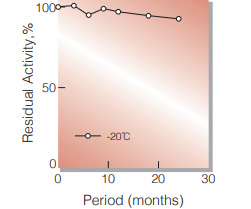
Fig.1. Stability (Powder form)
(kept under dry conditions)
-
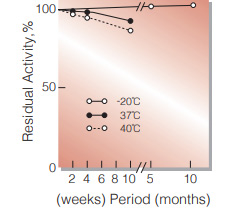
Fig.2. Stability (Powder form)
(kept under dry conditions)
-
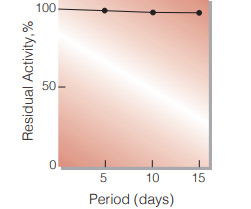
Fig.3. Stability (Liquid form at 37℃)
enzyme concentration: 400-500U/mL buffer composition: 50mM K-phosphate buffer contg.3.2M ammonium sulfate and 0.2 % BSA, pH7.0
-
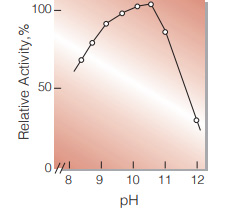
Fig.4. pH-Activity
(25℃, in 0.1M K2CO3-NaHCO3 buffer)
-
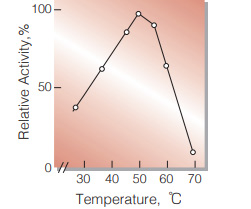
Fig.5. Temperature activity
(in 0.1M K2CO3-NaHCO3 buffer, pH10.5)
-
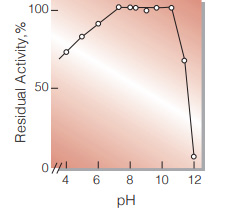
Fig.6. pH-Stability
25℃, 20hr-treatment with 50mM buffer solution pH4.0-6.0,acetate: pH6.0-8.5, K-phosphate;pH9.0-11.8, K2CO3- NaHCO3
-
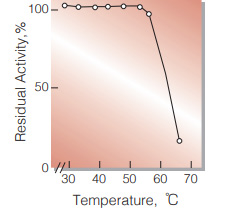
Fig.7. Thermal stability
15min-treatment with 50mM K-phosphate buffer, pH 7.5
活性測定法(Japanese)
1. 原理

NADHの生成量を340nmの吸光度の変化で測定する。
2.定義
下記条件下で1分間に1マイクロモルのNADHを生成する酵素量を1単位 (U)とする。
3.試薬
- 0.2M K2CO3-NaHCO3緩衝液, pH11.0
- 0.3Mグリセロール水溶液
- 1.0M硫安溶液
- 10mM NAD+水溶液(143.5mgのNAD+(MW=717.45)を蒸留水18 mLに溶解し, 0.5N KOHでpH7.0に調整後, 蒸留水で20 mLとする)(用時調製)
酵素溶液:酵素標品を予め氷冷した20mM K-リン酸緩衝液, pH7.5で溶解し,同緩衝液で0.10〜0.25U/mLに希釈して氷冷保存する。
4.手順
1.下記反応混液を使用直前に調製する。
| 30.0 mL | K2CO3-NaHCO3緩衝液 | (A) |
| 20.0 mL | 基質溶液 | (B) |
| 2.0 mL | 硫安溶液 | (C) |
| 6.0 mL | NAD+水溶液 | (D) |
pHが10.0〜10.5の範囲にあることを確認, pHがこの範囲外の場合は1.0N KOHまたは1.0N HClで10.5に調製し,褐色瓶中で氷冷保存する。
2.反応混液2.9 mLをキュベット(d=1.0cm)に採り,25℃で約5分間予備加温する。
3.③酵素溶液0.1 mLを添加し,ゆるやかに混和後,水を対照に25℃に制御された分光光度計で340nmの吸光度変化を3〜4分間記録し,その初期直線部分から1分間当りの吸光度変化を求める(ΔOD test)。
4.盲検は反応混液①2.9 mLに,酵素溶液の代りに酵素希釈液(20mM K-リン酸緩衝液, pH7.5)を0.1 mL加え,上記同様に操作を行って,1分間当りの吸光度変化を求める(ΔOD blank)。
5.計算式
U/mL =
-
ΔOD/min (ΔOD test−ΔOD blank)×3.0(mL)×希釈倍率
6.22×1.0×0.1(mL)
| = ΔOD/min×4.82×希釈倍率 | |
| U/mg | = U/mL×1/C |
| 6.22 | : NADHのミリモル分子吸光係数(cm2/micromole) |
| 1.0 | : 光路長(cm) |
| C | : 溶解時の酵素濃度(c mg/mL) |
CONTACT
-
For inquiries and cosultations regarding our products, please contact us through this number.
- HEAD OFFICE+81-6-6348-3843
- Inquiry / Opinion
